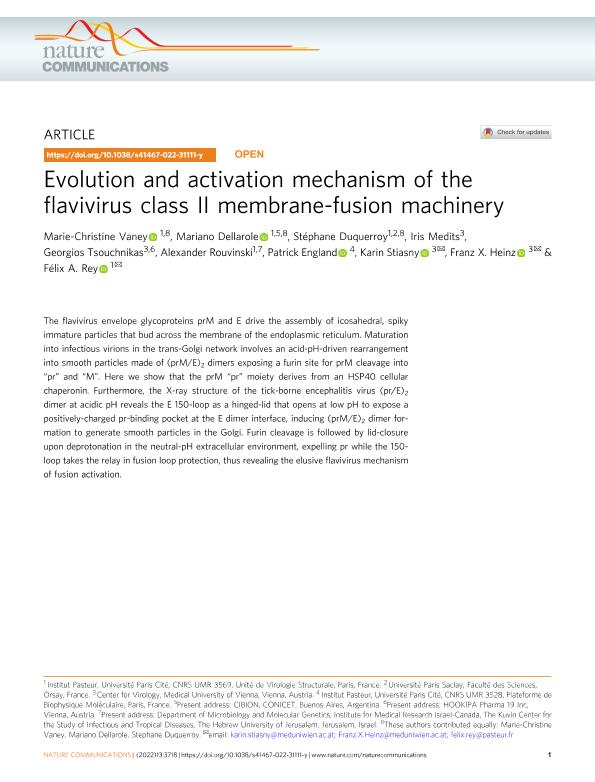Mostrar el registro sencillo del ítem
dc.contributor.author
Vaney, Marie Christine
dc.contributor.author
Dellarole, Mariano

dc.contributor.author
Duquerroy, Stéphane
dc.contributor.author
Medits, Iris
dc.contributor.author
Tsouchnikas, Georgios
dc.contributor.author
Rouvinski, Alexander
dc.contributor.author
England, Patrick
dc.contributor.author
Stiasny, Karin
dc.contributor.author
Heinz, Franz X.
dc.contributor.author
Rey, Félix Augusto

dc.date.available
2023-07-14T20:28:30Z
dc.date.issued
2022-12
dc.identifier.citation
Vaney, Marie Christine; Dellarole, Mariano; Duquerroy, Stéphane; Medits, Iris; Tsouchnikas, Georgios; et al.; Evolution and activation mechanism of the flavivirus class II membrane-fusion machinery; Nature; Nature Communications; 13; 1; 12-2022; 1-12
dc.identifier.issn
2041-1723
dc.identifier.uri
http://hdl.handle.net/11336/204059
dc.description.abstract
The flavivirus envelope glycoproteins prM and E drive the assembly of icosahedral, spiky immature particles that bud across the membrane of the endoplasmic reticulum. Maturation into infectious virions in the trans-Golgi network involves an acid-pH-driven rearrangement into smooth particles made of (prM/E)2 dimers exposing a furin site for prM cleavage into “pr” and “M”. Here we show that the prM “pr” moiety derives from an HSP40 cellular chaperonin. Furthermore, the X-ray structure of the tick-borne encephalitis virus (pr/E)2 dimer at acidic pH reveals the E 150-loop as a hinged-lid that opens at low pH to expose a positively-charged pr-binding pocket at the E dimer interface, inducing (prM/E)2 dimer formation to generate smooth particles in the Golgi. Furin cleavage is followed by lid-closure upon deprotonation in the neutral-pH extracellular environment, expelling pr while the 150-loop takes the relay in fusion loop protection, thus revealing the elusive flavivirus mechanism of fusion activation.
dc.format
application/pdf
dc.language.iso
eng
dc.publisher
Nature

dc.rights
info:eu-repo/semantics/openAccess
dc.rights.uri
https://creativecommons.org/licenses/by/2.5/ar/
dc.rights.uri
https://creativecommons.org/licenses/by/2.5/ar/
dc.subject
Flavivirus
dc.subject
mecanismo de maduración
dc.subject
E pr
dc.subject
cristalografía
dc.subject.classification
Biofísica

dc.subject.classification
Ciencias Biológicas

dc.subject.classification
CIENCIAS NATURALES Y EXACTAS

dc.title
Evolution and activation mechanism of the flavivirus class II membrane-fusion machinery
dc.type
info:eu-repo/semantics/article
dc.type
info:ar-repo/semantics/artículo
dc.type
info:eu-repo/semantics/publishedVersion
dc.date.updated
2023-07-10T11:55:40Z
dc.journal.volume
13
dc.journal.number
1
dc.journal.pagination
1-12
dc.journal.pais
Reino Unido

dc.description.fil
Fil: Vaney, Marie Christine. Institut Pasteur de Paris.; Francia
dc.description.fil
Fil: Dellarole, Mariano. Consejo Nacional de Investigaciones Científicas y Técnicas. Oficina de Coordinación Administrativa Parque Centenario. Centro de Investigaciones en Bionanociencias "Elizabeth Jares Erijman"; Argentina
dc.description.fil
Fil: Duquerroy, Stéphane. Institut Pasteur de Paris.; Francia
dc.description.fil
Fil: Medits, Iris. Medical University Of Vienna; Austria
dc.description.fil
Fil: Tsouchnikas, Georgios. Medical University Of Vienna; Austria
dc.description.fil
Fil: Rouvinski, Alexander. Institut Pasteur de Paris.; Francia
dc.description.fil
Fil: England, Patrick. Institut Pasteur de Paris.; Francia
dc.description.fil
Fil: Stiasny, Karin. Medical University Of Vienna; Austria
dc.description.fil
Fil: Heinz, Franz X.. Medical University Of Vienna; Austria
dc.description.fil
Fil: Rey, Félix Augusto. Institut Pasteur de Paris.; Francia
dc.journal.title
Nature Communications

dc.relation.alternativeid
info:eu-repo/semantics/altIdentifier/doi/http://dx.doi.org/10.1038/s41467-022-31111-y
Archivos asociados
